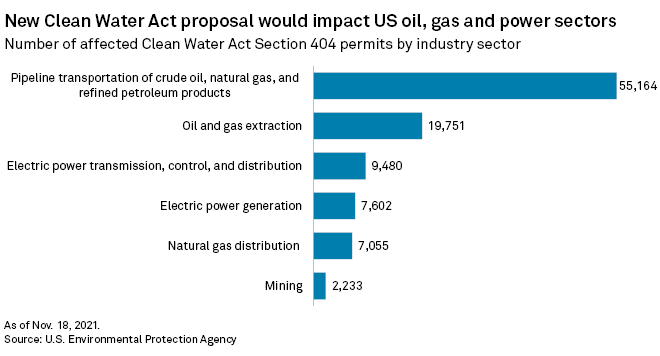S&P Global Offerings
Featured Topics
Featured Products
Events
S&P Global Offerings
Featured Topics
Featured Products
Events
S&P Global Offerings
Featured Topics
Featured Products
Events
Banking & Capital Markets
Economy & Finance
Energy Transition & Sustainability
Technology & Innovation
Podcasts & Newsletters
Banking & Capital Markets
Economy & Finance
Energy Transition & Sustainability
Technology & Innovation
Podcasts & Newsletters
S&P Global Offerings
Featured Topics
Featured Products
Events
19 Nov, 2021

| Slick Rock Channel, Slide Rock State Park, Ariz. Source: DeepDesertPhoto/Getty Creative via Getty Images |
The Biden administration on Nov. 18 moved to reverse a Trump-era Clean Water Act rule that would have eased permitting obstacles for energy infrastructure by stripping the statute's protections from about half the nation's wetlands and nearly one-fifth of its ephemeral streams.
At issue is a Trump-era Navigable Waters Protection Rule, or NWPR, issued by the U.S. Environmental Protection Agency and U.S. Army Corps of Engineers. It replaced an Obama-era rule aimed at clarifying which waters are covered by the Clean Water Act's permitting programs.
Under the Clean Water Act's permitting program, project developers seeking to dredge or fill protected waters must obtain a permit under Section 404 of the statute. To obtain a permit, developers must show that they have taken steps to avoid impacts to wetlands, streams and other resources. Potential impacts must be minimized and compensation must be provided for all remaining unavoidable impacts.
The NWPR adopted a legal interpretation authored by the late U.S. Supreme Court Justice Antonin Scalia, who argued in the court's complicated Rapanos v. United States decision that water bodies must share a "continuous surface connection" to receive Clean Water Act protections.
Lower courts had previously favored a separate test authored by former Justice Anthony Kennedy, who won support from a majority of judges in the 5-4 Rapanos decision by arguing that federal jurisdiction under the statute applies when surface waters and wetlands share a "significant nexus."
Under the Trump-era regulation, Clean Water Act protections would have been eliminated from at least 51% of all U.S. wetlands relative to the Obama-era rule. It also would have removed protections for 18% of ephemeral streams or water features throughout the U.S. that only contain water during or in response to rainfall.
On his first full day in office, U.S. President Joe Biden issued an executive order directing the EPA and Army Corps to review the rule.
With that review still ongoing, in August a federal district court judge in Arizona vacated the Trump-era regulation after concluding it could cause "serious environmental harm." In doing so, the judge noted that that nearly every one of the roughly 1,500 streams in New Mexico and Arizona assessed under the NWPR were no longer covered by the Clean Water Act.
Projected impact
The Biden administration's replacement proposal, signed Nov. 18 by EPA Administrator Michael Regan, would reinstate Kennedy's "significant nexus" test.
"With the significant nexus standard, the proposed rule is properly focused on protecting the foundational waters clearly protected by the Clean Water Act," the EPA said in a draft version of the regulation.
The change would have a significant impact on U.S. oil, natural gas, and electric power facilities, the agencies' economic analysis found. Out of an estimated 550,000 affected facilities, approximately 40% are in the oil production sector. More than 16,000 power generation and electric transmission facilities would be affected as well.

The EPA said in a Nov. 18 news release that the agencies will continue to consult with stakeholders to further refine their Clean Water Act interpretation in a future regulatory action.
Comments on the EPA's proposed rule are due 60 days after its publication in the Federal Register.
